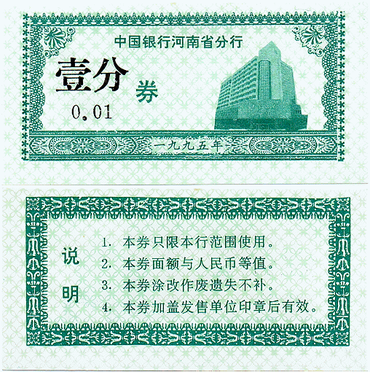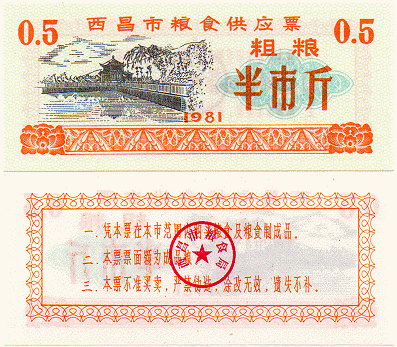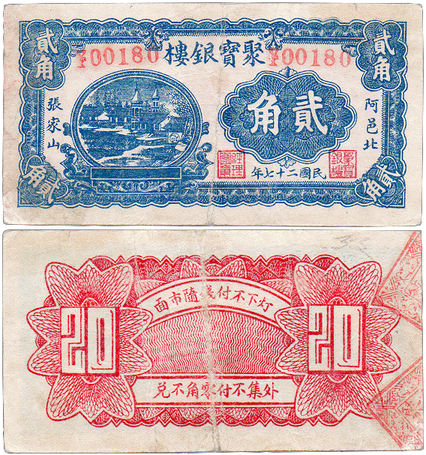A Bank of China 'Oddity'
The Henan branch small change issues of 1995

Though the focus personally, and of this site, is usually on pre-1970s currency issues, there are a few later items that provoke interest. Among these are an unusual pair of small change notes issued in 1995 by the Henan branch of the Bank of China: a green 0.01 Yuan (1 Fen) and a pink 0.05 Yuan (5 Fen)
With an all Chinese text, to the non-Chinese collector (or a non-observant Chinese reading one!) these two uncommon notes at first appear to be nothing more than examples of commodities coupons of the type found in great quantities, and issued across China from the 1950s until the 1990s (see an example at the foot of this page). However, these notes are currency issues of the Renminbi yuan - the national currency since 1949.
As such, these are unusual. According to law, only the Peoples Bank of China is supposed to issue Renminbi - though the Bank of China functioned as a division of the PBC from 1950 until the 1980s, and is still a government bank. The notes are printed on watermarked security paper of the type used for the national RMB issues of the Peoples Bank of China and in particular the Foreign Exchange Certificates (which was the only other currency issued by the Bank of China since 1942). Each note is dated and carries a vignette depicting the Henan branch office building. They are known to be only useable up to a total of amount of 1 Yuan.

The question however is why were these notes introduced? From what I've managed to discover, there seems to be two conflicting explanations.
The first is that these were issued as emergency Renminbi Aid coupons in 1995, due to a temporary lack of small coinage, and apparently limited to a circulation of two weeks with most having since been destroyed.
The second explanation is that these are discontinued low value denominations from a series of internally issued money or coupons for the use of employees of the Bank of China and redeemable at bank facilities and affiliated establishments (shops, cafe's, restaurant's, and so forth). There are of course many far older examples of similar items issued to employees and customers of businesses (see example below).
Which of these explanations is the most likely to be correct is difficult to say; perhaps one day this mini-mystery will be resolved conclusively.
The first is that these were issued as emergency Renminbi Aid coupons in 1995, due to a temporary lack of small coinage, and apparently limited to a circulation of two weeks with most having since been destroyed.
The second explanation is that these are discontinued low value denominations from a series of internally issued money or coupons for the use of employees of the Bank of China and redeemable at bank facilities and affiliated establishments (shops, cafe's, restaurant's, and so forth). There are of course many far older examples of similar items issued to employees and customers of businesses (see example below).
Which of these explanations is the most likely to be correct is difficult to say; perhaps one day this mini-mystery will be resolved conclusively.
(left) a 1981 commodity coupon from Xichang City, Sichuan Province, for 0.5 jin of grain.
(right) An example of small-change commercial currency or coupons issued widely, mostly during the early Republic. This example was a 20 cents issued by Ju bao yin lou - Zhu Bao ‘silver company’ in Hopeh (Hebei) province, in 1938.
(right) An example of small-change commercial currency or coupons issued widely, mostly during the early Republic. This example was a 20 cents issued by Ju bao yin lou - Zhu Bao ‘silver company’ in Hopeh (Hebei) province, in 1938.


